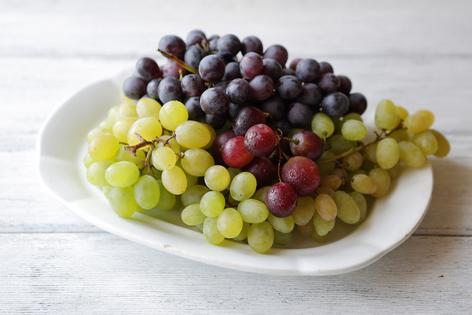Environmental Nutrition: Grape expectations
The thousands of grape varieties come in many sizes, textures and colors that include the most common green, red and black, but also pink, yellow and purple. And there's even more to learn about this tiny fruit.
The folklore
The storied history of grapes runs deeper than the roots of the twisted vines themselves. Called the "fruit of the vine" in the bible, grapes are believed by some to be the fruit eaten by Eve in the Garden of Eden. Grapes also appear in hieroglyphics in Egyptian burial tombs, but it was the Greeks and Romans who coveted them for winemaking. Wine and grapes were known for their nutritional and medicinal value as early as the middle ages. A traditional symbol of bounty and abundance, grapes (and the wine that is produced from them) continue to be embedded in the food and celebratory traditions of cultures around the world and are recognized for their high nutrient density.
The facts
Grapes are classified into three categories, all part of the Vitaceae family. Table grapes are eaten fresh or in recipes, wine grapes are grown to make wine, and raisin grapes are used to make dried fruit. Grapes are antioxidant power balls, packing 27 percent Daily Value of vitamin C in a one-cup serving, in addition to well over 100 other health-promoting plant chemicals with antioxidant action, such as beta-carotene, melatonin, and resveratrol.
The findings
Resveratrol and the many other antioxidant compounds in grapes have consistently shown benefits when it comes to both oxidative stress and inflammation, conditions that lead to aging. According to a 2016 review of studies published in Oxidative Medicine and Cellular Longevity, grape-derived products help prevent age-associated damage, including Alzheimer's dementia, an age-related brain disease. However, research (Annals of the New York Academy of Science, 2015) also shows that eating the whole grape provides a natural combination of health promoting plant chemicals that appear to work together and may lead to improved health and disease prevention. Other studies suggest these synergistic interactions may even work to help prevent and fight cancer (Molecular Nutrition and Food Research, 2016).
The finer points
Plump berries with green, pliable stems indicate a fresh, ripe bunch of grapes. Red grapes are very sweet, green are sweet, but less so, and black are the least sweet of the three. Try a variety for an adventure in color, flavor, and texture. Grapes keep best -- up to two weeks -- unwashed and refrigerated. Wash them just before use. Enjoy fresh or frozen grapes on their own as a handy, hydrating snack, or toss them into salads, side dishes and desserts for a blast of color and a touch of sweetness. Fresh, uncooked grapes pack the most nutrients, but when roasted, grilled or sauteed, they perk up whatever's on the menu, from a whole-grain side to a refreshing relish atop fish or chicken.
(Environmental Nutrition is the award-winning independent newsletter written by nutrition experts dedicated to providing readers up-to-date, accurate information about health and nutrition in clear, concise English. For more information, visit www.environmentalnutrition.com.)







